Tools for the 21st century musician
Soledad Penadés
@supersole
Let’s start with a supposition:
You all are musicians or artists
and very edgy!
So you want to break fronteers;
go where no one has been before:
bring your art to the web!
Oh, I know, with <audio>, eh?
We could use it...
<audio src="cool_song.ogg" controls preload></audio>
This would...
- initiate network request for loading
- deal with decoding/streaming/buffering
- render audio controls
- display progress indicator, time...
It could also trigger some events!
- loadeddata
- error
- ended
- ... etc
And has methods you can use
- load
- play
- pause
But it has shortcomings...
- hard to accurately schedule
- triggering multiple instances of same sound requires a hack
- they're associated to a DOM element
- output goes straight to the speakers - no fancy visualisations
- in some systems the OS will display a fullscreen player overlay
This won’t do for edgy artists
Is it all over?
Do we just give up and start writing native apps?
NO
Web Audio
to the rescue!
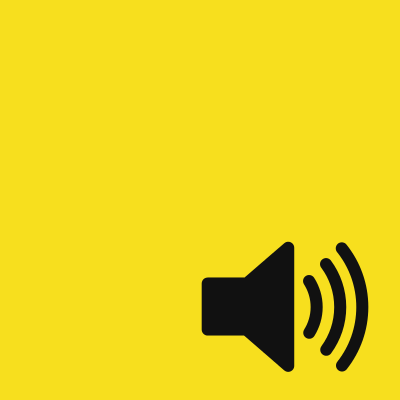
Web Audio...
- is modular
- interoperable with other JS/Web APIs
- not attached to the DOM
- runs in a separate thread
- 2014: supported in many browsers!
So how does it work?
We create an audio context
var audioContext = new AudioContext();
AudioContext
“Where everything happens”
AudioContext
- methods to create audio nodes
- some nodes generate audio
- others alter it
- others examine it
- they all form the audio graph
The audio graph? ô_Ô
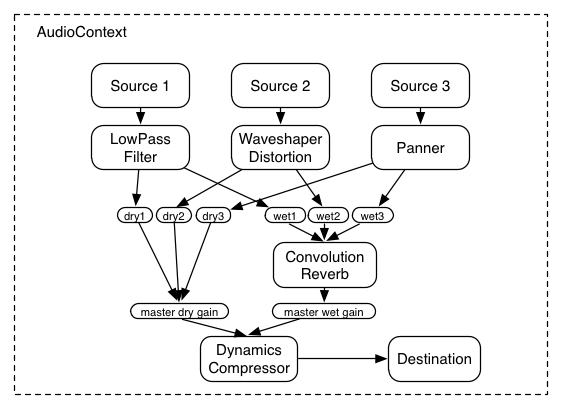
Let’s make some noise
var audioContext = new AudioContext();
var oscillator = audioContext.createOscillator();
oscillator.connect(audioContext.destination);
oscillator.start(audioContext.currentTime);Starting/stopping
// start it now
oscillator.start(audioContext.currentTime);
// 3 seconds from now
oscillator.start(audioContext.currentTime + 3)
// stop it now
oscillator.stop(audioContext.currentTime);
// start it again
oscillator.start(audioContext.currentTime); // !?!
Why can’t oscillators be restarted?
Welcome to your first Web Audio...
GOTCHA!
Because of performance reasons
One-use only nodes
- use and forget
- automatically disposed of by the GC
- as long as you don't keep references
- watch out for those memory leaks!
- the Web Audio Editor is super helpful
Write your own wrappers
Oscillator.js (1/3)
function Oscillator(context) {
var node = null;
var nodeNeedsNulling = false;
this.start = function(when) {
ensureNodeIsLive();
node.start(when);
};
Oscillator.js (2/3)
// continues
this.stop = function(when) {
if(node === null) {
return;
}
nodeNeedsNulling = true;
node.stop(when);
};
Oscillator.js (3/3)
// continues
function ensureNodeIsLive() {
if(nodeNeedsNulling || node === null) {
node = context.createOscillator();
}
nodeNeedsNulling = false;
}
}
Using it
var ctx = new AudioContext();
var osc = new Oscillator(ctx);
function restart() {
osc.stop(0);
osc.start(0);
}
osc.start(0);
setTimeout(restart, 1000);
Self regenerating oscillator
But before I continue...
It would be nice to see what is going on!
Let’s use an
AnalyserNode
AnalyserNode, 1
var analyser = context.createAnalyser();
analyser.fftSize = 2048;
var analyserData = new Float32Array(
analyser.frequencyBinCount
);
oscillator.connect(analyser);
AnalyserNode, 2
requestAnimationFrame(animate);
function animate() {
analyser.getFloatTimeDomainData(analyserData);
drawSample(canvas, analyserData);
}
Analyser
Now,
can we play something other than that beep?
Yes!
Nodes have properties we can change, e.g.
oscillator.type
- sine
- square
- sawtooth
- triangle
- custom
oscillator.type = 'square';
Wave types
oscillator.frequency
Naive attempt:
oscillator.frequency = 880;It doesn’t work!😬
oscillator.frequency
is an AudioParam
It is special
// Access it with
oscillator.frequency.value = 880;So what is the point of AudioParam?
Superpowers.
Superpower #1
Scheduling changes with accurate timing
What NOT to do
- setInterval
- setTimeout
Stepped sounds
AudioParam approach
Web Audio keeps a list of timed events per parameter
- setValueAtTime
- linearRampToValueAtTime
- exponentialRampToValueAtTime
- setTargetAtTime
- setValueCurveAtTime
Go from 440 to 880 Hz in 3 seconds
osc.frequency.setValueAtTime(
440,
audioContext.currentTime
);
osc.frequency.linearRampToValueAtTime(
880,
audioContext.currentTime + 3
);Minigotchas
- avoid using param.value --it doesn’t add an event to the list
- avoid using 0 as when--times have to be ascending
Let’s build an ADSR envelope

ADSwhat...?
- Attack Decay Sustain Release
- Used a lot in substractive synthesis
- Relatively easy to configure and compute
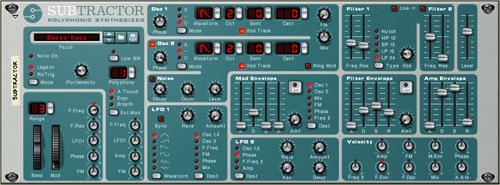
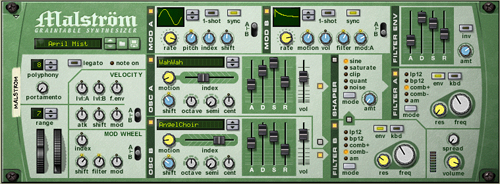
We need a new node for controlling the volume
GainNode
var ctx = new AudioContext();
var osc = ctx.createOscillator();
var gain = ctx.createGain(); // *** NEW
osc.connect(gain); // *** NEW
gain.connect(ctx.destination); // *** NEW
ADSR part 1
// Attack/Decay/Sustain phase
gain.gain.setValueAtTime(
0,
audioContext.currentTime
);
gain.gain.linearRampToValueAtTime(
1,
audioContext.currentTime + attackLength
);
gain.gain.linearRampToValueAtTime(
sustainValue,
audioContext.currentTime + attackLength + decayLength
);
ADSR part 2
// Release phase
gain.gain.linearRampToValueAtTime(
0,
audioContext.currentTime + releaseLength
);
Envelopes
Cancelling events!
osc.frequency.cancelScheduledEvents(
audioContext.currentTime
);
Superpower #2
Modulation
Connect the output of one node to another node’s AudioParam
LFOs

LFOs
We can’t hear those frequencies...
but can use them to alter other values we can notice!
SPOOKY SOUNDS
Watch out!
var context = new AudioContext();
var osc = context.createOscillator();
var lfOsc = context.createOscillator();
var gain = context.createGain();
lfOsc.connect(gain);
// The output from gain is the [-1, 1] range
gain.gain.value = 100;
// now the output from gain is in the [-100, 100] range!
gain.connect(osc.frequency); // NOT the destination
KEEP watching out
osc.frequency.value = 440;
// oscillation frequency is 1Hz = once per second
lfOsc.frequency.value = 1;
osc.start();
lfOsc.start();
spooky LFOs
Playing existing samples
- AudioBufferSourceNode for short samples (< 1 min)
- MediaElementAudioSourceNode for longer sounds
AudioBufferSourceNode, 1
var context = new AudioContext();
var pewSource = context.createBufferSource();
var request = new XMLHttpRequest();
request.open('GET', samplePath, true);
request.responseType = 'arraybuffer'; // we want binary data 'as is'
request.onload = function() {
context.decodeAudioData(
request.response,
loadedCallback, errorCallback
);
};
AudioBufferSourceNode, 2
var abs = context.createBufferSource();
function loadedCallback(bufferSource) {
abs.buffer = bufferSource;
abs.start();
}
function errorCallback() {
alert('No PEW PEW for you');
}
AudioBufferSourceNode, 3
Just like oscillators!
abs.start(when);
abs.stop(when);
AudioBufferSourceNode even die like oscillators!
Pssst:
You can create them again and reuse the buffer
pewpewmatic
MediaElementAudioSourceNode
Takes the output of <audio> or <video> and incorporates them into the graph.
var video = document.querySelector('video');
var audioSourceNode =
context.createMediaElementAudioSource(
video
);
audioSourceNode.connect(context.destination);
Media element
More Web Audio nodes
- delay
- filter (low/pass/high frequencies)
- panning (3D sounds!)
- reverb (via convolver)
- splitter
- waveshaper
- compressor
Their parameters can also be modulated and automated!
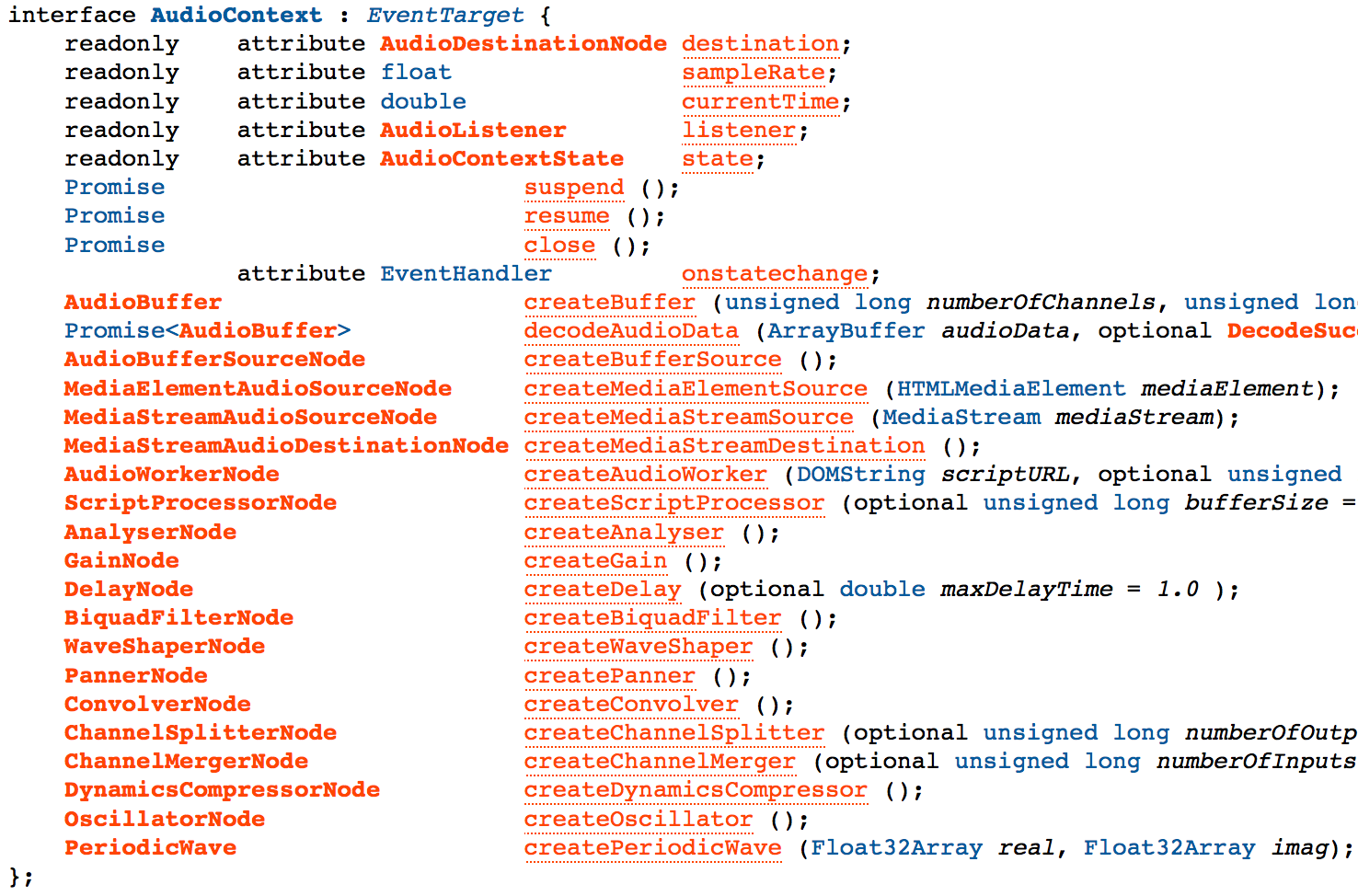
Wait, there is more!
Mix all the APIs!
- Using getUserMedia + MediaElementAudioSourceNode
- Web Audio Workers - generate audio in realtime with JavaScript
- OfflineAudioContext - render as fast as possible! Beat detection, etc...
- ???
- BE EDGY!
And there is
STILL more!
I've been hacking on Web Audio stuff for the last 3 years
so I've done the same things over and over
in different ways
I've also spoken to many people about audio stuff
- Angelina Fabbro saw my <audio-tags> and said "hey this looks promising, let's do more of this!", so they created a GitHub org for "audio stuff"
But we didn't know what exactly to put in there... - Jordan Santell discussed his component based audio components.
- Max Ogden and his little modules made me understand "the Node Way"
At some point the stars aligned:
- I finally understood AudioParams
- I found the way to simulate custom audio nodes
- and I was going to speak about music in the 21st century
Suddenly everything made sense
It was, at last, the moment for...
(dramatic pause)
OpenMusic
Modules and components
for Web Audio
github.com/openmusic
OpenMusic right now:
- web components: oscilloscope, slider
- audio components: oscillator, sample player, clipper, dcbias
- eventing: tracker player
- audio generation: noise functions (white, brown, pink)
All based on npm, dependencies sorted out on npm install
How it looks like
var Oscillator = require('openmusic-oscillator');
var ac = new AudioContext();
var osc = Oscillator(ac);
osc.connect(ac.destination);
osc.start();i.e. pretty much like other AudioNodes
Principles
- behave like standard AudioNodes
- one functionality, one module
- composable
Our wish:
- People use these bits and pieces
- Or they look at them and build their own and we can use theirs
- Bits and pieces become tools
- A web audio ecosystem forms...